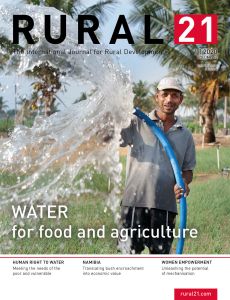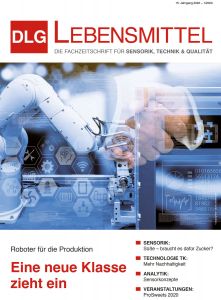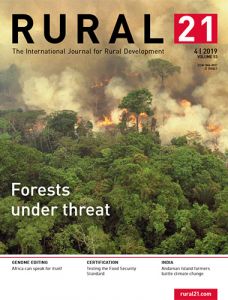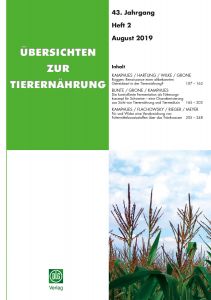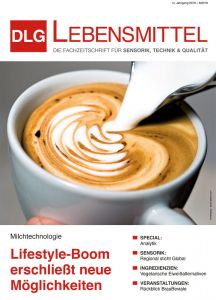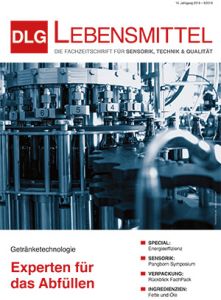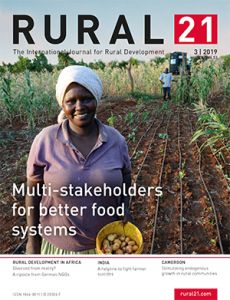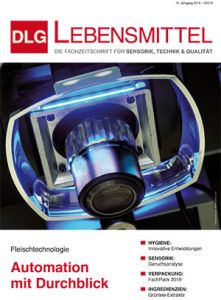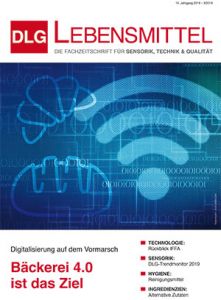Verstecke Angebote
-
Rural 21 (engl. Ausgabe 1/2020)
Focus 1/2020: Water for food and agriculture
Water is the basis of all life on Earth. Without water, agriculture, and hence food production, would not be possible, and this sector accounts for more than two thirds of global freshwater consumption. However, freshwater is a scarce resource. And it is becoming ever scarcer, also because of global warming effects. Here, clever solutions are needed, solutions ensuring that the scarce resource of water is used optimally while taking the needs of all stakeholders into consideration – in line with the “Leave no one behind” principle of the Sustainable Development Goals.
Erfahren Sie mehr -
DLG Lebensmittel 1/2020
Im Mittelpunkt des Heftes stehen Fachartikel und Praxisbeiträge zu den Themen "Lebensmittelqualität", "Sensorik", "Lebensmitteltechnologie", "Ingredienzien" sowie "Kommunikation/Marketing". Ein aktueller Blick in die Entwicklung der Lebensmittelmärkte rundet das Angebot ab. Damit werfen wir einen ganzheitlichen Blick auf die „Welt der Lebensmittel“ – von der Entwicklung, über die Produktion bis zur Vermarktung.
Erfahren Sie mehr -
Rural 21 (engl. Ausgabe 4/2019)
Focus 4/2019: Forests under threat
The world’s forests are under threat. Forest fires and deforestation are reaching frightening proportions. Even though considerable progress has been made in reforestation, this cannot obscure the simple fact that, at least in terms of tropical forests and primary forests, the net balance is negative – despite everyone being aware of the immense significance that forested landscapes in maintaining ecosystem equilibrium and for people’ livelihoods and well-being. Of course, besides seeking to draw attention to these worrying developments, our articles are above all meant to point to solutions. How can previously intact forest stocks be restored? What are the conditions that need to be created in order to avoid further deforestation and forest degradation? And above all, how can people in rural areas benefit from the environmental services of trees without a conflict arising between using and protecting the forest?
Erfahren Sie mehr -
Übersichten zur Tierernährung 2/2018
erscheint 2x jährlich
Erfahren Sie mehr -
DLG Lebensmittel 6/2019
Im Mittelpunkt des Heftes stehen Fachartikel und Praxisbeiträge zu den Themen "Lebensmittelqualität", "Sensorik", "Lebensmitteltechnologie", "Ingredienzien" sowie "Kommunikation/Marketing". Ein aktueller Blick in die Entwicklung der Lebensmittelmärkte rundet das Angebot ab. Damit werfen wir einen ganzheitlichen Blick auf die „Welt der Lebensmittel“ – von der Entwicklung, über die Produktion bis zur Vermarktung.
Erfahren Sie mehr -
DLG Lebensmittel 5/2019
Im Mittelpunkt des Heftes stehen Fachartikel und Praxisbeiträge zu den Themen "Lebensmittelqualität", "Sensorik", "Lebensmitteltechnologie", "Ingredienzien" sowie "Kommunikation/Marketing". Ein aktueller Blick in die Entwicklung der Lebensmittelmärkte rundet das Angebot ab. Damit werfen wir einen ganzheitlichen Blick auf die „Welt der Lebensmittel“ – von der Entwicklung, über die Produktion bis zur Vermarktung.
Erfahren Sie mehr -
Rural 21 (engl. Ausgabe 3/2019)
Focus 3/2019: Multi-stakeholders for better food systems
The more globalisation moves forward, the more complex the interplay between different stakeholders becomes. Sustainable Development Goal 17 is dedicated to partnerships for the goals to harmonise and plan interaction among multi-stakeholders together. But what does this mean for the agricultural and food sector in rural areas in particular? A food system comprises not only traditional value chains, but also consumption and the environment. This calls for concerted action among governments, the private sector and civil society to achieve a sustainable and healthy food system, including its value chains, while considering the different conflicts of interest among the parties involved. In order to understand each other, a common language should be created. This can be achieved through standards and certifications, but also through clearly formulated agreements such as in contract farming. Over the last decades, products produced under labour and social standards or certified by sustainability standards such as Fairtrade or organic standards have come into play and are more popular with the consumer side. But who benefits from this? Is it the small-scale farmers, who have to adapt their production, increase their income and yields, reduce health and environmental risks caused by inappropriate farming practices and enhance nutrition diversity on their own plate while creating traceability and transparency at the same time?
This edition gives special emphasis to this complexity of actors and their interests to work together, sometimes even at inter-sector level. There is no one-size-fits-all approach, for local circumstances play an important role. We have chosen examples of typical interactions in food systems either to show who is involved in a particular case and what the outcome is – the added value of the common action – or to point out advantages and disadvantages of all actors involved and their incentive to participate in a specific step in the value chain.
Erfahren Sie mehr -
DLG Lebensmittel 4/2019Im Mittelpunkt des Heftes stehen Fachartikel und Praxisbeiträge zu den Themen "Lebensmittelqualität", "Sensorik", "Lebensmitteltechnologie", "Ingredienzien" sowie "Kommunikation/Marketing". Ein aktueller Blick in die Entwicklung der Lebensmittelmärkte rundet das Angebot ab. Damit werfen wir einen ganzheitlichen Blick auf die „Welt der Lebensmittel“ – von der Entwicklung, über die Produktion bis zur Vermarktung. Erfahren Sie mehr
-
DLG Lebensmittel 3/2019Im Mittelpunkt des Heftes stehen Fachartikel und Praxisbeiträge zu den Themen "Lebensmittelqualität", "Sensorik", "Lebensmitteltechnologie", "Ingredienzien" sowie "Kommunikation/Marketing". Ein aktueller Blick in die Entwicklung der Lebensmittelmärkte rundet das Angebot ab. Damit werfen wir einen ganzheitlichen Blick auf die „Welt der Lebensmittel“ – von der Entwicklung, über die Produktion bis zur Vermarktung. Erfahren Sie mehr
-
DLG Lebensmittel 2/2019Im Mittelpunkt des Heftes stehen Fachartikel und Praxisbeiträge zu den Themen "Lebensmittelqualität", "Sensorik", "Lebensmitteltechnologie", "Ingredienzien" sowie "Kommunikation/Marketing". Ein aktueller Blick in die Entwicklung der Lebensmittelmärkte rundet das Angebot ab. Damit werfen wir einen ganzheitlichen Blick auf die „Welt der Lebensmittel“ – von der Entwicklung, über die Produktion bis zur Vermarktung. Erfahren Sie mehr

